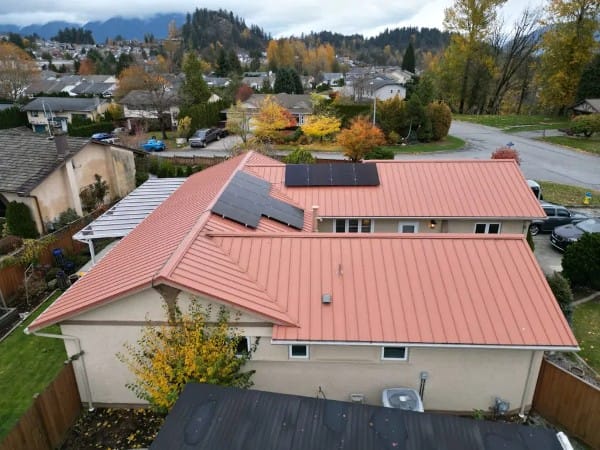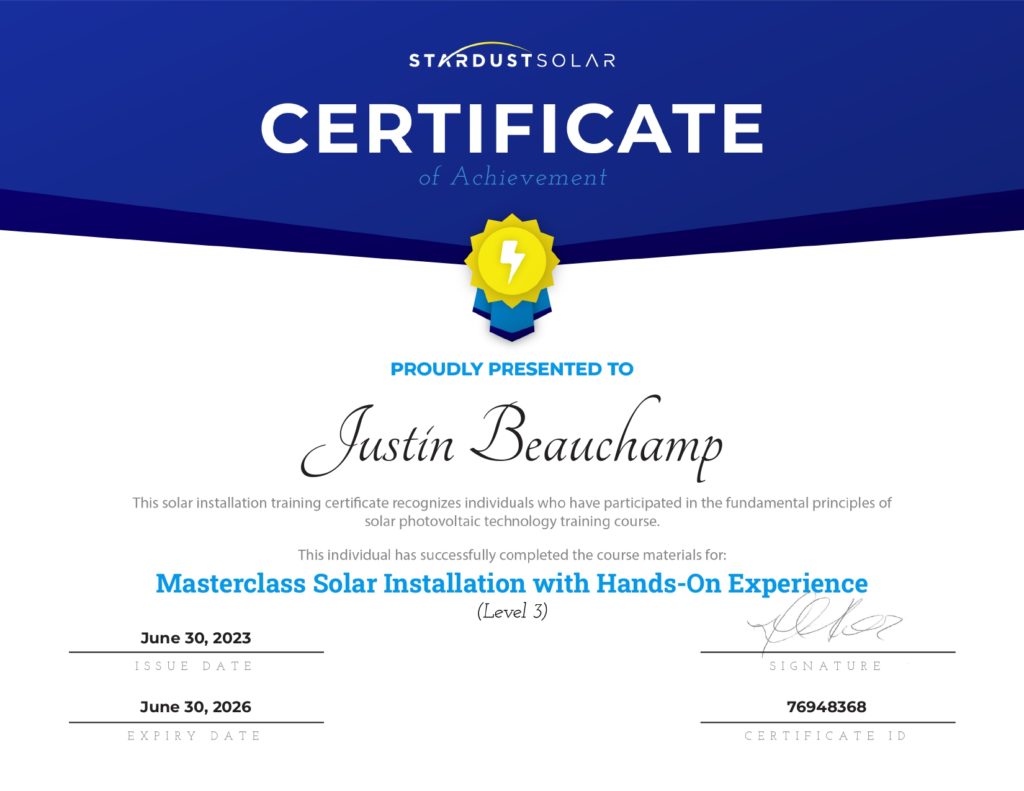Calgary’s cold winters and warm summers present unique challenges and opportunities for solar energy adoption. With 333 sunny days per year, Calgary’s climate is ideal for solar power despite its harsh winters.
To assist residents in determining the financial viability of solar panel installation, the City of Calgary has updated the residential solar calculator.
This free tool shows how much productive roof space a home has through satellite imagery. It can even detect roof orientation, pitch, and obstructions or shadows that may affect solar potential.
However, the decision-making process depends on more factors like initial investment, energy savings, and panel efficiency in Calgary’s weather. This blog explores the climate and solar energy in Calgary and highlights the essential factors to consider when installing solar in Calgary.
Choose MAG Solar for professional solar panel installation and start saving on your energy bills today!
The Climate and Solar Potential of Calgary
The continental climate of Calgary brings cold winters and warm summers. The city gets 2,396 hours of sunlight annually, or 6.6 hours daily. Despite freezing temperatures, Calgary’s high solar irradiance is essential for solar energy production.
Weather and Normal Sunlight Hours
Winters in Calgary often drop below -10°C, and summers are short and warm, averaging 22°C. An average of 333 sunny days per year make the city ideal for solar energy.
- Panel exposure is maximized by 16-hour daylight in summer.
- Despite shorter winter days with 8 hours of sunlight, PV panels can still be more efficient due to lower thermal losses.
Solar Energy Production Analysis
- Monitoring stations’ data shows that panels can reach near maximum capacity in June and July, generating 5-6 kWh/m²/day.
- Production decreases in winter, especially in December and January when daily solar radiation drops to 1.5-2 kWh/m²/day.
- Despite this decrease, the annual average solar energy production is high due to clear skies and high solar irradiance in other seasons.
The Effect of Seasons on Solar Panel Efficiency
Seasonal changes affect PV panel efficiency directly. Lower ambient temperatures improve photovoltaic cell efficiency in winter. However, panel snow can block sunlight and reduce energy production.
Modern PV systems have tilt adjustments and automated cleaning to prevent snow damage. In Calgary, panels should be tilted 45-50 degrees to maximize solar exposure year-round.
Solar Panels in Calgary: What Experts Think
In 2022, the University of Calgary School of Architecture, Planning, and Landscape (SAPL) held “On Solar Neighborhoods,” a groundbreaking seminar on sustainable urban planning and renewable energy integration.
- The seminar featured international and Canadian experts discussing urban planning strategies for solar energy.
- Experts from countries with similar climates provided case studies and success stories to prove solar neighbourhoods are possible.
- Improved renewable project implementation and digitalization for energy exploitation were discussed in built environments.
Dr. Caroline Hachem-Vermette, who led the seminar and leads Task 63 on Solar Neighborhood Planning at the International Energy Agency, has long promoted solar energy in diverse climates. The seminar showed how solar energy can adapt and strengthen communities. Dr. Hachem-Vermette expresses, “We need energy source diversity.”
Her 2022 seminar insights are still helpful as Calgary and other regions consider renewable technology strategy:
- Panels work well in Calgary despite the misconception that they only work in sunny climates.
- Calgary solar panels offer long-term savings and environmental benefits.
- Lower energy bills and government incentives for renewable energy offset the initial investment.
- Modern PV technology has made panels more efficient and affordable.
Solar Energy During Winter Months (November – March)
The November–March winter in Calgary presents solar energy production challenges. Using strategic solutions to overcome these challenges can optimize energy production even in harsh winter conditions.
Low Daylight and High Cloud Cover Challenges
Winter in Calgary averages 8 hours of daylight, compared to 16 in summer. This decrease in daylight naturally limits solar panel power generation.
- The sun’s lower angle in winter reduces sunlight intensity.
- Winter cloud cover reduces direct sunlight reaching panels.
- Clouds diffuse sunlight, reducing energy output.
- Cloudy days can generate some electricity from panels, but not as much as sunny days.
Impact of Snow and Ice on PV Panels
- Snow can cover panels, block sunlight, and reduce electricity generation.
- Depending on the amount and type of snow, even a thin layer can reduce solar panel output by 100%. Ice can form reflective layers on panels, thus blocking sunlight.
- May damage or wear out the system and may need more maintenance.
Solar Energy Production Optimization Strategies for Cold Climates
| Strategy | Description | Advantages |
| Panel Placement and Tilt Adjustments | Panels must be tilted to maximize low-angle winter sunlight and shed snow. In Calgary, winter tilt angles should be around 60 degrees. |
|
| Snow Guards and Heating Elements | Snow guards prevent large snow slides, while heating elements melt snow and ice before accumulation. |
|
| Scheduled Cleaning and Maintenance | Regular inspections and cleanings remove snow and ice. Ensures exposure to sunlight. |
|
| Technological Advances | Improved panel technologies, like bifacial panels and special coatings, enhance winter performance. |
|
Solar Installation in Calgary: What You Need to Know
Examining Solar Suitability
- Conducting a Site Assessment. This evaluation considers location, average radiation, and potential obstacles to sunlight exposure. A professional assessment will consider the site’s high number of sunny days, the sun’s angle, and local weather patterns.
- Testing Roof Condition, Orientation, and Shading. Roofs should be structurally sound and last 25–30 years or longer than PV panels. South-facing panels in Calgary maximize sunlight exposure.
- Trees, buildings, and chimneys can cast shadows on panels. Solar pathfinders and software-based shading analysis can help optimize energy production by minimizing shading.
Finding the Right Solar System
Choose Calgary-Suitable Panels and Inverters
- Many recommend monocrystalline panels for their efficiency and versatility. While less efficient, polycrystalline panels are cost-effective.
- Efficient and reliable inverters should be used to convert the panels’ direct current (DC) to alternating current (AC) for home use.
- Microinverters or power optimizers are ideal for partial shading.
Consider System Size Based on Energy Use
- The PV system’s size should match the household or business’s energy needs.
- A quarterly and seasonal energy audit can determine system size based on average energy usage.
- Consider future energy needs, energy storage, and budget constraints.
Professional Setup and Maintenance
Experienced solar installers are essential for proper and safe solar installation. Accredited installers know local building codes, permitting, and solar installation best practices. MAG Solar offers warranties and guarantees to give you peace of mind and protect your investment.
- Regular Inspections and Maintenance for Best Performance. Annual inspections should check panels, mounting structures, electrical connections, and inverters. Clean the panels, check for damage or wear, and test the system components.
- Dealing with Snow Removal and Winterization. Improving insulation and protecting electrical components from extreme cold can prevent damage and maintain efficiency during harsh weather.
Calgary’s Strategic Solar Investments
It is worth installing solar panels in Calgary despite the weather, as the city has made strategic investments in solar projects. The City hopes large-scale solar energy projects will pay for themselves in 10-12 years by lowering utility costs and greenhouse gas emissions.
- Haskayne Legacy Park Solar Project. A Net Zero Building Solar Power initiative at the Haskayne Legacy Park Pavilion.
- Shepard Park. A “Brightfield” project with a capacity of 1,080 kW, constructed on a former race track.
- Bearspaw Water Treatment Plant. A 626.7-kW solar PV project completed in November 2017.
- Renfrew Solar Carport. The City of Calgary’s first solar PV carport system, developed in partnership with the Spark Science Centre in 2023.

Install Your Calgary Solar Panel System Today
Calgary and other similar climates have a bright future when it comes to renewable energy. Managing winter challenges with proactive measures and proper planning allows more residents and businesses to benefit from renewable energy solutions.
Accurate site assessments, appropriate PV system components, and installers from reliable solar companies like MAG Solar can ensure a successful and efficient installation. Our experienced solar installers can help with the complexities of PV installation and maintenance.
Frequently Asked Questions
Are solar panels durable enough to endure hailstorms in Calgary?
Modern panels can withstand hailstorms and other extreme weather. Weather-related warranties and impact resistance tests are standard on panels. However, high-quality panels and proper installation are necessary to maximize resilience.
Which kinds of panels work best in Calgary's climate?
Monocrystalline panels are recommended for Calgary due to their efficiency and weather resistance. Another option that can be useful in snowy conditions is bifacial panels, which can capture sunlight from both sides.
- The Longi 410 54-Cell module is an efficient solar panel that can handle up to 3% power variations.
- Our 445 Watt Longi Bi-Facial Solar Panels use advanced HPDC Technology for 22% module efficiency.
These premium panels are ideal and highly effective for the climate of Calgary. We tailor solar energy solutions to ensure lower electricity bill.
Can solar energy from sunny months be stored for winter?
Yes, energy storage devices like solar batteries can put the sun’s rays to good use even when the weather is gloomy. These batteries maximize your solar investment by providing reliable power during low solar production. You can also get credit for excess energy fed back into the grid with net metering.

